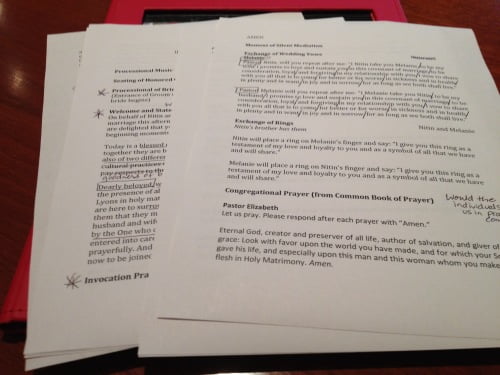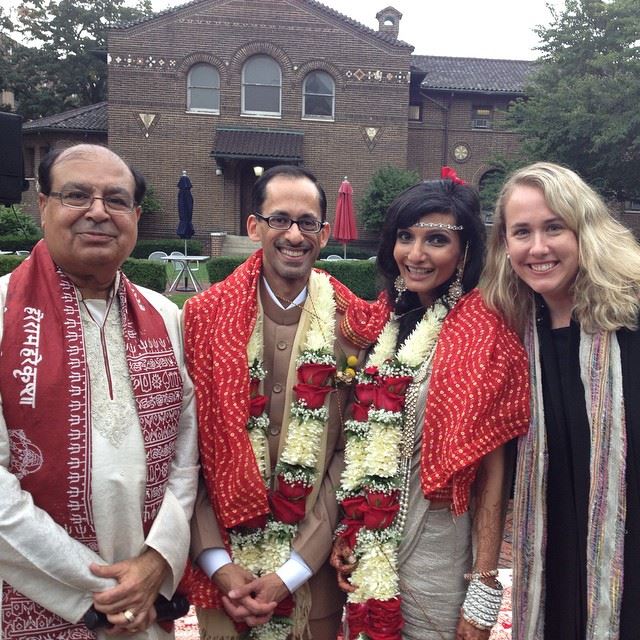This week's installment of the Preacher on the Plaza began like this:
Women sat dressed in their brightest and most colorful attire.
Sounds of ancient Indian melodic tunes echoed between the walls.
A fragrance of fresh cut rose pedals sweetened the air.
I quickly knew this would be no ordinary afternoon, for me.
Large portions of the script I held in my sermon folder were familiar, though. A well-worn white stole hung around my neck. Pieces of a bulletin from last Sunday (or maybe it was the week before?) filled the pocket of my robe.
In the middle of the museum’s Rotunda on the campus of the University of Pennsylvania, the groom stood beside me in a tan suit with a crème stole around his neck, much like mine.
Within minutes, the bride walked down the aisle in an exotic off-white sari and jewelry stemming from her nose and flowing down her ear lobes.
Soon I said words like this:
Dearly beloved we are gathered here today in the sight of God.
Marriage is a covenant not to be entered into lightly.
Repeat after me: with this ring, I thee wed.
Then, it would be my turn to sit down. Another religious professional took the reigns. In an adjourning courtyard, the gathered audience heard chanting in Sanskrit, offerings of food to God, and prayers for a long and happy future together.
For, this was an interfaith wedding, the bride, a devout convert to Christianity and the groom, Hindu. And at the end, as a sign of unity, the Hindu priest and I both pronounced them man and wife.
Though this was not my first interfaith wedding, it was my first Hindu one. (Just so you know, I’m in the “God is too big to fit into one religion” camp). As the Hindu part began, I observed a ceremony of string, fire and making offerings on the altar as I sat watching from one of those little white folding chairs.
 I have to admit the Hindu portion seemed odd at first. But, slowly as the priest translated the ritual into English my spirit resonated its intentions with those I’d just performed.
I have to admit the Hindu portion seemed odd at first. But, slowly as the priest translated the ritual into English my spirit resonated its intentions with those I’d just performed.
Commitment of the couple to each other.
Blessing their vows as a community.
Thanksgiving to God for this moment of joy.
Afterwards, when I was on the way back to my house for the evening, I couldn’t have been prouder. I felt sad the bride's pastor who said “no" to this amazing experience.
In my opinion, there isn’t anything more beautiful than an interfaith wedding.
In our growing cultural obsession with marrying fast and divorcing even faster, one might think that interfaith couples are doomed from the start. But not always.
A 1+1 faith doesn’t have to mean 0. It can actually mean a strengthening of bonds and faiths like my friend, Dana writes about frequently on her blog.
But not only this, I can’t think of a braver thing to do than to marry someone outside your own tradition, even if you come from the same cultural background (as the couple I married did). It’s hard work to find your footing when the partner walking beside you is on a different path. It’s hard work that requires much sacrifice. Interfaith coupling is not for the weak-hearted. And, I admire that!
Interfaith weddings are also beautiful because they have a lot to teach us about God. Though we as Christians may call God—Father, Son and Holy Ghost—there are other lovers of our God who may call God by other names, or sing God other kinds of songs, or even pray to God with different kinds of petitions. Hearing God’s praise in an unfamiliar context gives us the chance to behold God anew.
You need to know about me that I don’t do non-religious ceremonies. I am not a judge or the justice of the peace. I don’t know how to plan a wedding without invoking God’s name or reading scripture. If a couple wants a non-religious ceremony, I help them find the appropriate person.
But interfaith weddings—that’s a whole other lovely thing.
My own experience with God grows as I plan and learn. What could be better than that?
I’ll gladly lead another interfaith wedding soon (I hope!) and pray for this new couple that their bonds grow deep in all the days to come.